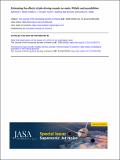Files in this item
Estimating the effects of pile driving sounds on seals : pitfalls and possibilities
Item metadata
| dc.contributor.author | Whyte, Katherine Fae | |
| dc.contributor.author | Russell, Debbie JF | |
| dc.contributor.author | Sparling, Carol Elizabeth | |
| dc.contributor.author | Binnerts, Bas | |
| dc.contributor.author | Hastie, Gordon Drummond | |
| dc.date.accessioned | 2020-12-16T00:37:19Z | |
| dc.date.available | 2020-12-16T00:37:19Z | |
| dc.date.issued | 2020-06 | |
| dc.identifier | 268446042 | |
| dc.identifier | 58510b3c-9714-4f6f-b966-edaabc39ea05 | |
| dc.identifier | 000542726600002 | |
| dc.identifier | 85087652896 | |
| dc.identifier.citation | Whyte , K F , Russell , D JF , Sparling , C E , Binnerts , B & Hastie , G D 2020 , ' Estimating the effects of pile driving sounds on seals : pitfalls and possibilities ' , Journal of the Acoustical Society of America , vol. 147 , no. 6 , pp. 3948-3958 . https://doi.org/10.1121/10.0001408 | en |
| dc.identifier.issn | 0001-4966 | |
| dc.identifier.other | ORCID: /0000-0002-1969-102X/work/75996588 | |
| dc.identifier.other | ORCID: /0000-0002-9773-2755/work/75996861 | |
| dc.identifier.other | ORCID: /0000-0003-3388-9603/work/75997027 | |
| dc.identifier.other | ORCID: /0000-0001-7658-5111/work/89178118 | |
| dc.identifier.uri | https://hdl.handle.net/10023/21156 | |
| dc.description | Funding: Data collection was funded as part of the Department of Energy and Climate Change’s (now Department of Business, Energy and Industrial Strategy) Offshore Energy Strategic Environmental Assessment programme, with additional resources from National Capability funding from the Natural Environment Research Council to the Sea Mammal Research Unit (Grant No. SMRU1001). Sound propagation modelling and subsequent analyses were funded by RaceBank Wind Farm Ltd. KFW was funded by University of St Andrews and the Department of Business, Energy and Industrial Strategy, as part of a PhD studentship. | en |
| dc.description.abstract | Understanding the potential effects of pile driving sounds on marine wildlife is essential for regulating offshore wind developments. Here, tracking data from 24 harbour seals were used to quantify effects and investigate sensitivity to the methods used to predict these. The Aquarius pile driving model was used to model source characteristics and acoustic propagation loss (16 Hz–20 kHz). Predicted cumulative sound exposure levels (SELcums) experienced by each seal were compared to different auditory weighting functions and damage thresholds to estimate temporary (TTS) and permanent (PTS) threshold shift occurrence. Each approach produced markedly different results; however, the most recent criteria established by Southall et al. [(2019) Aquat. Mamm. 45, 125–232] suggests that TTS occurrence was low (17% of seals). Predictions of seal density during pile driving made by Russell et al. [(2016) J. Appl. Ecol. 53, 1642–1652] were compared to distance from the wind farm and predicted single-strike sound exposure levels (SELss) by multiple approaches. Predicted seal density significantly decreased within 25 km or above SELss (averaged across depths and pile installations) of 145 dB re 1 μPa²·s. However, there was substantial variation in SELss with depth and installation, and thus in the predicted relationship with seal density. These results highlight uncertainty in estimated effects, which should be considered in future assessments. | |
| dc.format.extent | 1595864 | |
| dc.language.iso | eng | |
| dc.relation.ispartof | Journal of the Acoustical Society of America | en |
| dc.subject | GC Oceanography | en |
| dc.subject | QH301 Biology | en |
| dc.subject | DAS | en |
| dc.subject | NERC | en |
| dc.subject | BEIS/DECC | en |
| dc.subject | SDG 14 - Life Below Water | en |
| dc.subject.lcc | GC | en |
| dc.subject.lcc | QH301 | en |
| dc.title | Estimating the effects of pile driving sounds on seals : pitfalls and possibilities | en |
| dc.type | Journal article | en |
| dc.contributor.sponsor | NERC | en |
| dc.contributor.sponsor | NERC | en |
| dc.contributor.institution | University of St Andrews. School of Biology | en |
| dc.contributor.institution | University of St Andrews. Sea Mammal Research Unit | en |
| dc.contributor.institution | University of St Andrews. Marine Alliance for Science & Technology Scotland | en |
| dc.contributor.institution | University of St Andrews. Scottish Oceans Institute | en |
| dc.contributor.institution | University of St Andrews. Centre for Research into Ecological & Environmental Modelling | en |
| dc.identifier.doi | https://doi.org/10.1121/10.0001408 | |
| dc.description.status | Peer reviewed | en |
| dc.date.embargoedUntil | 2020-12-16 | |
| dc.identifier.grantnumber | Agreement R8-H12-86 | en |
| dc.identifier.grantnumber | NE/R015007/1 | en |
This item appears in the following Collection(s)
Items in the St Andrews Research Repository are protected by copyright, with all rights reserved, unless otherwise indicated.

